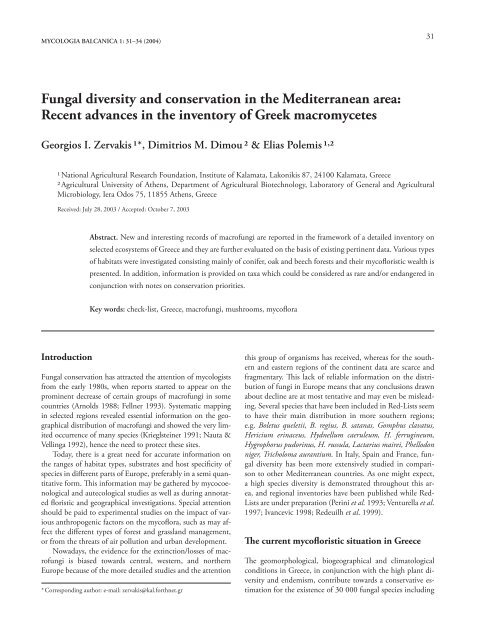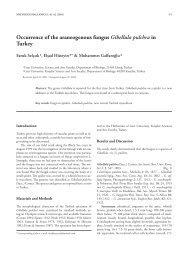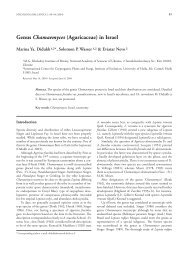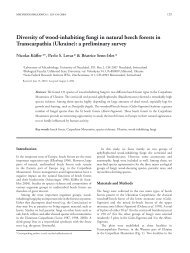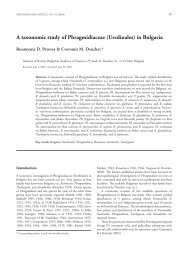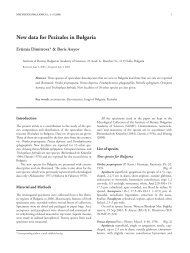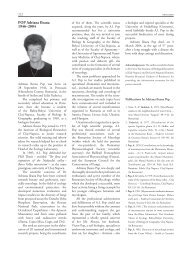Full text - Mycologia Balcanica
Full text - Mycologia Balcanica
Full text - Mycologia Balcanica
You also want an ePaper? Increase the reach of your titles
YUMPU automatically turns print PDFs into web optimized ePapers that Google loves.
MYCOLOGIA BALCANICA 1: 31–34 (2004)<br />
Fungal diversity and conservation in the Mediterranean area:<br />
Recent advances in the inventory of Greek macromycetes<br />
Georgios I. Zervakis 1*, Dimitrios M. Dimou 2 & Elias Polemis 1,2<br />
1 National Agricultural Research Foundation, Institute of Kalamata, Lakonikis 87, 24100 Kalamata, Greece<br />
2 Agricultural University of Athens, Department of Agricultural Biotechnology, Laboratory of General and Agricultural<br />
Microbiology, Iera Odos 75, 11855 Athens, Greece<br />
Received: July 28, 2003 / Accepted: October 7, 2003<br />
Introduction<br />
Abstract. New and interesting records of macrofungi are reported in the framework of a detailed inventory on<br />
selected ecosystems of Greece and they are further evaluated on the basis of existing pertinent data. Various types<br />
of habitats were investigated consisting mainly of conifer, oak and beech forests and their mycofl oristic wealth is<br />
presented. In addition, information is provided on taxa which could be considered as rare and/or endangered in<br />
conjunction with notes on conservation priorities.<br />
Key words: check-list, Greece, macrofungi, mushrooms, mycofl ora<br />
Fungal conservation has attracted the attention of mycologists<br />
from the early 1980s, when reports started to appear on the<br />
prominent decrease of certain groups of macrofungi in some<br />
countries (Arnolds 1988; Fellner 1993). Systematic mapping<br />
in selected regions revealed essential information on the geographical<br />
distribution of macrofungi and showed the very limited<br />
occurrence of many species (Krieglsteiner 1991; Nauta &<br />
Vellinga 1992), hence the need to protect these sites.<br />
Today, there is a great need for accurate information on<br />
the ranges of habitat types, substrates and host specifi city of<br />
species in diff erent parts of Europe, preferably in a semi quantitative<br />
form. Th is information may be gathered by mycocoenological<br />
and autecological studies as well as during annotated<br />
fl oristic and geographical investigations. Special attention<br />
should be paid to experimental studies on the impact of various<br />
anthropogenic factors on the mycofl ora, such as may affect<br />
the diff erent types of forest and grassland management,<br />
or from the threats of air pollution and urban development.<br />
Nowadays, the evidence for the extinction/losses of macrofungi<br />
is biased towards central, western, and northern<br />
Europe because of the more detailed studies and the attention<br />
* Corresponding author: e-mail: zervakis@kal.forthnet.gr<br />
31<br />
this group of organisms has received, whereas for the southern<br />
and eastern regions of the continent data are scarce and<br />
fragmentary. Th is lack of reliable information on the distribution<br />
of fungi in Europe means that any conclusions drawn<br />
about decline are at most tentative and may even be misleading.<br />
Several species that have been included in Red-Lists seem<br />
to have their main distribution in more southern regions;<br />
e.g. Boletus queletii, B. regius, B. satanas, Gomphus clavatus,<br />
Hericium erinaceus, Hydnellum caeruleum, H. ferrugineum,<br />
Hygrophorus pudorinus, H. russula, Lactarius mairei, Phellodon<br />
niger, Tricholoma aurantium. In Italy, Spain and France, fungal<br />
diversity has been more extensively studied in comparison<br />
to other Mediterranean countries. As one might expect,<br />
a high species diversity is demonstrated throughout this area,<br />
and regional inventories have been published while Red-<br />
Lists are under preparation (Perini et al. 1993; Venturella et al.<br />
1997; Ivancevic 1998; Redeuilh et al. 1999).<br />
Th e current mycofl oristic situation in Greece<br />
Th e geomorphological, biogeographical and climatological<br />
conditions in Greece, in conjunction with the high plant diversity<br />
and endemism, contribute towards a conservative estimation<br />
for the existence of 30 000 fungal species including
32<br />
6000-7000 macromycetes. Until now, the total number of<br />
the recorded fungal species in Greece is approx. 3500, among<br />
which 1800 represent mushrooms.<br />
However, the total number of fungi reported above represents<br />
a draft estimation since it does not include recent data<br />
on the diversity of microfungi; calculations were based on the<br />
Fungus-Host Index for Greece (Pantidou 1973).<br />
Actually, the most adequately surveyed groups belong<br />
to the plant pathogenic fungi, to the Homobasidiomycetes,<br />
and to the larger ascomycetes. For example, 230 species of<br />
Aphyllophorales s. lat. have been recorded out of an estimated<br />
total of 550; 580 recorded species of Agaricales out of<br />
2400; 50 recorded species of gasteromycetes out of 150; 20<br />
recorded species of jelly fungi out of 200; 70 recorded species<br />
of Pezizales out of 150; and 15 recorded species of Xylariales<br />
out of 300; calculated number of species was inferred following<br />
Rossman (1994) and Hawksworth (2001), and our own<br />
estimations.<br />
As regards macromycetes, pertinent knowledge was very<br />
poor until the 1990s (Zervakis et al. 1998, 1999). However,<br />
signifi cant progress on their inventory and mapping has been<br />
accomplished during the last decade and it has resulted in an<br />
increase of ca 100% of the number of the recorded species.<br />
Novel and interesting records from various<br />
ecosystems of Greece<br />
Special attention was drawn to typical Mediterranean ecosystems<br />
and largely under-explored regions of continental<br />
Greece and Aegean islands (Zervakis 2001). A detailed inventory<br />
of macrofungi was carried out during the last six years for<br />
the following ecosystems:<br />
a. A typical Abietion cephalonicae phytosociety in Mt.<br />
Taygetos (southern Peloponnissos, alt. 800-1400 m) dominated<br />
by Abies cephalonica J.W. Loudon and Pinus nigra<br />
Arnold subsp. pallasiana (Lamb.) Holmboe. Th is area is<br />
representative of the chorological type of southern Greece<br />
(Peloponnissos and south-central Greece), it presents a weak<br />
mid-mediterranean to sub-mediterranean climate (Zervakis et<br />
al. 2002a).<br />
b. Th e deciduous oak forests of central Peloponnissos<br />
(alt. 200-900 m) are classifi ed within the para-Mediterranean<br />
Quercetalia pubescentis phytosociety (Quercion confertae suballeance),<br />
which extends throughout continental Greece, presenting<br />
a weak mid-mediterranean to sub-mediterranean bioclimatic<br />
type. Quercus frainetto Ten. is the dominant species<br />
often forming mixed groups (as well as hybrids) with Q. pubescens<br />
Willd. (Zervakis et al. 2002b).<br />
c. Th e southernmost beech forest in the Balkan Peninsula<br />
(Mt. Oxya, Sterea Hellas, central Greece), which consists of<br />
mixed Fagus sylvatica L. and F. moesiaca (K. Malý) Czecz. trees<br />
(1300-1800 m) and the adjacent alpine region (Dimou et al.<br />
2002).<br />
d. Th e Abies cephalonica forests of the east side of Mt.<br />
Oxya (850-1300 m) intermixed at lower altitudes mainly<br />
zervakis, g.i., dimou, d.m. & polemis, e. — advances in the inventory of greek macromycetes<br />
with Castanea sativa Miller, Quercus spp., and Pinus nigra (authors‘<br />
unpubl. data).<br />
e. Various other regions in continental Greece (Nafpaktia<br />
Mts., Mt. Parnitha, Mt. Dirfi , Mt. Oiti, Mt. Ossa, Mt. Pilion,<br />
Mt. Tymfi , etc.) and in the Aegean islands (Andros, Naxos,<br />
Agios Efstratios, Kythira, Crete, etc.) (authors‘ unpubl. data).<br />
All collected specimens are deposited in the herbarium<br />
at the authors Institutes (NAGREF-IK and LGAM-AUA),<br />
while a photographic archive is also maintained.<br />
During this extensive investigation over 800 macromycete<br />
species were recorded, among which more than 200 constituted<br />
fi rst records for Greece, while a great number were<br />
detected on new host/substrata or ecosystems (e.g. Dimou et<br />
al. 2002; Polemis et al. 2002; Zervakis et al. 2002a, b; and authors‘<br />
unpubl. data). In addition, thirty-eight genera were recorded<br />
for the fi rst time:<br />
Amphinema P. Karst., Amylocorticium Pouzar (Mt.<br />
Taygetos), Antrodiella Ryvarden & I. Johans. (Mt.<br />
Oxya on conifers), Athelia Pers. (Mt. Taygetos, Evvoia),<br />
Botryobasidium Donk (Mt. Taygetos), Botryohypochnus<br />
Donk (Mt. Oxya, Nafpactia), Byssocorticium Bondartsev &<br />
Singer (Mt. Oxya), Ceratobasidium D.P. Rogers (Naxos),<br />
Ceriporia Donk (Evvoia), Crustomyces Jülich (Mt. Oxya),<br />
Colus Cavalier & S chier (Cyclades, Evvoia, Fthiotida),<br />
Cylindrobasidium Jülich (Evrytania), Dentipellis Donk (Mt.<br />
Oxya), Diplomitoporus Domanski (Mt. Oxya on conifers),<br />
Endoptychum Czern. (Mt. Oxya), Exidiopsis (Bref.)<br />
A. Moeller (Mt. Oxya on conifers), Faerberia Pouzar (Mt.<br />
Taygetos), Fayodia Kühner (Mt. Taygetos), Fibulomyces Jülich<br />
(Mt. Kallidromo), Galeropsis Velen. (Mt. Oxya), Geoglossum<br />
Pers. (Mt. Taygetos), Gloeocystidiellum Donk (Nafpactia),<br />
Gyrophragmium Mont. (Messinia, Andros), Leucocoprinus Pat.<br />
(Athens), Leucocortinarius (J.E. Lange) Singer (Mt. Oxya),<br />
Litschaurella Oberw. (Mt. Taygetos), Mycenastrum Desv. (Mt.<br />
Oxya, Mt. Dirfi in conifers, Nafpactia), Mycoaciella J. Erikss.<br />
& Ryvarden (Andros), Myxarium Wallr. (Cyclades), Oxyporus<br />
(Bourdot & Galzin) Donk (Mt. Oxya), Phaeomarasmius<br />
Scherff . (Nafpactia on Carpinus orientalis Miller), Phlebiella<br />
P. Karst. (Arkadia and Evvoia), Physisporinus P. Karst. (Mt.<br />
Oxya), Porostereum Pilat (Messinia), Simocybe P. Karst.<br />
(Andros, Naxos), Sistotrema Fr. (Mt. Taygetos), Th elephora<br />
Ehrh. & Willd. (Mt. Oxya on soil), Vararia P. Karst. (Agios<br />
Efstratios), Veluticeps Hjortstam & Telleria (Mt. Taygetos)<br />
(Dimou et al. 2002; Polemis et al. 2002; Zervakis et al. 2002a,<br />
b; and authors‘ unpubl. data).<br />
In addition, of signifi cant ecological and/or taxonomic interest<br />
were the following fi ndings classifi ed within the respective<br />
groups:<br />
a. Wood-inhabiting fungi: Ceriporia purpurea (Fr.)<br />
Donk, Kotsikia (Evvoia) on pine construction-wood, and on<br />
Laurus nobilis L. (Andros island); Ceriporia viridans (Berk.<br />
& Broome) Donk, Gardiki (Fthiotida) on Abies cephalonica;<br />
Crustomyces subabruptus (Bourdot & Galzin) Jülich, Mt. Oxya
mycologia balcanica 1 (2004)<br />
on Fagus sylvatica; Cylindrobasidium laeve (Pers.) Chamuris,<br />
Proussos (Evrytania) on Platanus orientalis L.; Fibulomyces<br />
mutabilis (Bres.) Jülich, Mt. Kallidromo (Fthiotida) on Pinus<br />
sp.; Galeropsis madagascariensis Singer, Gardiki (Fthiotida) on<br />
grassy soil under Alnus glutinosa (L.) Gaertner and Platanus<br />
orientalis mixed stands; Gloeocystidiellum leucoxanthum (Bres.)<br />
Boidin, Mt. Oxya on Fagus sylvatica; Gloeocystidiellum luridum<br />
(Bres.) Boidin, Nafpactia on Carpinus orientalis; Hyphoderma<br />
argillaceum (Bres.) Donk, Nafpactia on Junglans regia L.;<br />
Hypoxylon fuscum (Pers.) Fr., Nafpactia on Carpinus orientalis;<br />
Oligoporus fragilis (Fr.) Gilb. & Ryvarden, Mt. Taygetos<br />
and Mt. Oxya on Abies cephalonica; Oxyporus corticola (Fr.)<br />
Ryvarden, Mt. Oxya on Fagus sylvatica; Pleurotus dryinus<br />
(Pers.) P. Kumm., Mt. Oxya on Fagus sylvatica; Phlebia lilascens<br />
(Bourdot) J. Erikss. & Hjortstam, Vovoussa (Ioannina)<br />
on Fagus sylvatica; Podofomes pyrenaicus F. Rath, Mt. Parnitha<br />
on Abies cephalonica; Porostereum spadiceum (Pers.) Hjortstam<br />
& Ryvarden, Kampos (Messinia) on Olea europaea L.;<br />
Sistotrema brinkmannii (Bres.) J. Erikss., Mt. Taygetos on<br />
Pinus nigra; Tomentella badia (Link) Stalpers, Nafpactia on<br />
Castanea sativa; Tubulicrinis calothrix (Pat.) Donk, Nafpactia<br />
on Abies cephalonica.<br />
b. Secotioid fungi recorded in dry regions with warm<br />
weather, whose occurrence is rarely recorded: Endoptychum<br />
agaricoides Czern., Mt. Oxya at high elevations and in manured<br />
soils; Galeropsis madagascariensis; Gyrophragmium<br />
dunalii (Fr.) Zeller.<br />
c. Macrofungi which are particularly abundant in burned<br />
regions and/or appear in large numbers after fi res (e.g. Mt.<br />
Taygetos, conifers forest): Geopyxis carbonaria (Alb. &<br />
Schwein.) Sacc., Gyromitra infula (Schaeff .) Qučl., Helvella<br />
leucomelaena (Pers.) Nannf., Morchella conica Pers., Peziza violacea<br />
Pers., Plicaria trachycarpa (Curr.) Boud., Coprinus angulatus<br />
Peck, Faerberia carbonaria (Alb. & Schwein.) Pouzar,<br />
Fayodia maura (Fr.) Singer, Galerina vittiformis (Fr.) Singer,<br />
Lyophyllum sphaerosporum Kühner & Romagn., Pholiota highlandensis<br />
(Peck) Quadr. & Lunghini, Psathyrella pennata (Fr.)<br />
Konrad & Maubl.<br />
d. Taxa associated with Cistus spp. and other typical<br />
plants of the Mediterranean fl ora (located mainly in the<br />
islands of Andros and Naxos) (Polemis et al. 2002; authors‘<br />
unpublished data): Marasmius anomalus Peck var.<br />
microsporus (Maire) Antonín on stems of Phoeniculum<br />
vulgare; Marasmius corbariensis (Roum.) Singer on leaves<br />
of Olea europaea; Hebeloma album Peck, H. cistophilum<br />
Maire, Lactarius cistophilus Bon & Trimbach and L. tesquorum<br />
Malençon associated with shrubs of the genus Cistus;<br />
Peniophora tamaricicola Boidin & Malençon on Tamarix<br />
spp. and on Pistacia lentiscus L.; Ceriporiopsis gilvescens<br />
(Bres.) Domański on Nerium oleander L.; Aleurodiscus cerussatus<br />
(Bres.) Höhn. & Litsch. var. minor Pilat on Juniperus<br />
phoenicea L. and Cistus sp.; Crepidotus luteolus (Lambotte)<br />
Sacc. and Dacryomyces lacrymalis (Pers.) Sommerf. on<br />
Nerium oleander; Hyphodontia sambuci (Pers.) J. Erikss.<br />
on Juniperus oxycedrus L. subsp. macrocarpa (Sm.) Ball,<br />
Euphorbia acanthothamnos Heldr. & Sart. ex Boiss., Th ymus<br />
33<br />
capitatus (L.) Hoff manns & Link, Genista acanthoclada<br />
DC.; Byssomerulius corium (Pers.) Parmasto on Nerium oleander,<br />
Myrtus communis L., Tamarix sp., Pistacia lentiscus;<br />
Polyporus meridionalis (A. David) H. Jahn on Erica arborea<br />
L.; Peniophora lycii (Pers.) Höhn. & Litsch. on Tamarix sp.,<br />
Genista acanthoclada, Pistacia lentiscus, and Calycotome villosa<br />
(Poiret) Link.<br />
Final considerations and concerns<br />
On the basis of the recently obtained information (it might<br />
still be considered incomplete since there are inadequate data<br />
from past research studies, let alone from detailed inventories),<br />
a number of macrofungi could be considered as rare for<br />
Greece, e.g. Battarraea stevenii (Libosch.) Fr., Calvatia pachyderma<br />
(Peck) Morgan, Clitocybe phyllophila (Pers.) P. Kumm.,<br />
Clitocybula lacerata (Lasch) Singer, Crepidotus sphaerosporus<br />
(Pat.) J.E. Lange, Daedaleopsis confragosa (Bolton) J.<br />
Schröt., Dentipellis fragilis (Pers.) Donk, Endoptychum agaricoides<br />
Czern., Geastrum coronatum Pers., Gyroporus cyanescens<br />
(Bull.) Quél., Hohenbuehelia chevalieri (Pat.) Pegler,<br />
Hysterangium marchii Bres., Lactarius tabidus Fr., Laxi<strong>text</strong>um<br />
bicolor (Pers.) Lentz, Leucocortinarius bulbiger (Fr.) Singer,<br />
Macrocystidia cucumis (Pers.) Joss., Melanoleuca humilis<br />
(Pers.) Pat., Myriostoma coliforme (Dicks.) Corda, Panus rudis<br />
Fr., Pleurotus cornucopiae (Paulet) Rolland, Porodaedalea conchata<br />
(Pers.) Fiasson & Niemelä, Pulveroboletus auriporus<br />
(Peck) Singer, Resupinatus striatulus (Pers.) Murrill, Russula<br />
nigricans (Bull.) Fr., Tephrocybe rancida (Fr.) Donk, Tomentella<br />
ferruginea (Pers.) Pat., Tulostoma fi mbriatum Fr., Trichaptum<br />
biforme (Fr.) Ryvarden, Tricholoma colossum Fr., Xerula xeruloides<br />
(Bon) Dörfelt, etc.<br />
In Greece, human intervention has not yet caused the adverse<br />
eff ects it has in other European countries; however, it<br />
constitutes the main reason for high level concerns as regards<br />
macromycetes existence and disribution. Fungi considered<br />
to be in an endagered state are those growing in agricultural<br />
fi elds with cereal crops, in swamps, bogs and lake-sides, in<br />
fi re-susceptible forests or areas undergoing logging, in coastal<br />
ecosystems, as well as the wood-rotting species growing in old<br />
forests. Appropriate measures for the conservation of the mycofl<br />
ora include the prohibition of grazing (at least at vulnerable<br />
sites of particular biodiversity value), strict enforcement<br />
of existing laws concerning building activities within forest regions,<br />
intensifi cation of fi re-prevention measures, and establishment<br />
of protected areas where any anthropogenic activity<br />
should be minimized. In addition, of great need is the establishment<br />
of a national law regulating harvest of wild mushrooms,<br />
since there is a lack of any type of pertinent legislation<br />
in Greece.<br />
Acknowledgements. Th e research study was partially funded by the Greek<br />
General Secretariat of Research and Technology (project PENED95), the<br />
National Agricultural Research Foundation (project DIMITRA96), and
34<br />
the Agricultural University of Athens. Th e main part of this work was presented<br />
during the Round Table “Conservation and value of fungal diversity<br />
in the Mediterranean area” held in Cefalù (Palermo, Sicily) on November<br />
17th, 2001.<br />
References<br />
Arnolds, E. 1988. Th e changing macromycete fl ora in the Netherlands. –<br />
Transactions of the British Mycological Society 90: 391-406.<br />
Dimou, D., Zervakis, G. & Polemis, E. 2002. Mycodiversity studies in<br />
selected ecosystems of Greece: I. Macromycetes from the southernmost<br />
Fagus forest in the Balkans (Oxya Mountain, Central Greece). – Mycotaxon<br />
82: 177-205.<br />
Fellner, R. 1993. Air pollution and mycorrhizal fungi in central Europe. –<br />
In: D.N. Pegler, L. Boddy, B. Ing & P.M. Kirk [eds]. Fungi of Europe:<br />
Investigation, Recording and Conservation, pp. 239-250. Royal Botanic<br />
Gardens, Kew.<br />
Hawksworth, D.L. 2001. Th e magnitude of fungal diversity: the 1.5 million<br />
species estimate revisited. – Mycological Research 105: 1422-1432.<br />
Ivancevic, B. 1998. A preliminary red list of the macromycetes of Yugoslavia. –<br />
In: C. Perini [ed.]. Conservation of Fungi in Europe, pp. 57-61. European<br />
Council for the Conservation of Fungi, Vipiteno.<br />
Krieglsteiner, G.J. 1991. Verbreitungsatlas der Grosspilze Deutschlands (West).<br />
Band 1, 2. Ulmer Verlag, Stuttgart.<br />
Nauta, M. & Vellinga, E.C. 1992. Towards a distribution atlas of macrofungi<br />
in the Netherlands. – Mycologist 6: 6-10.<br />
Perini, C., Barluzzi, C. & De Dominicis, V. 1993. Fungal communities in<br />
Mediterranean and submediterranean woodlands. – In: D.N. Pegler, L.<br />
Boddy, B. Ing & P.M. Kirk [eds]. Fungi of Europe: Investigation, Recording<br />
and Conservation, pp. 77-92. Royal Botanic Gardens, Kew.<br />
zervakis, g.i., dimou, d.m. & polemis, e. — advances in the inventory of greek macromycetes<br />
Pantidou, M. 1973. Fungus-host index for Greece. Benaki Phytopathological<br />
Institute, Kiphissia.<br />
Polemis, E., Zervakis, G.I. & Dimou, D.M. 2002. New and interesting fi ndings<br />
of macromycetes from the islands of Andros and Naxos (Cyclades, Greece). –<br />
In: Th e 7th International Mycological Congress, Book of Abstracts, Oslo,<br />
11-17 August 2002. Pp. 169-170. Oslo.<br />
Redeuilh, G., Delannoy, A., Ravaux, P. & Courtecuisse, R. 1999. Current<br />
and forthcoming computer developments around the French mycological<br />
inventory program. – In: Book of Abstracts of the XIII Congress of European<br />
Mycologists, Universidad de Alcalŕ (Madrid, Spain), 21-25 September 1999.<br />
P. 111. Madrid.<br />
Rossman, A. 1994. A strategy for an all taxa inventory of fungal biodiversity. –<br />
In: C. Peng & A. Chou [eds]. Biodiversity and terrestrial ecosystems. Vol.<br />
14. Pp. 169-194. Taipei.<br />
Venturella G., Perini, C., Barluzzi, C., Pacioni, G., Bernicchia, A., Padovan,<br />
F., Quadraccia, L. & Onofri, S. 1997. Towards a Red Data List of fungi in<br />
Italy. – Bocconea 5: 867-872.<br />
Zervakis, G. 2001. Mycodiversity in Greece. – Bocconea 13: 119-124.<br />
Zervakis, G., Dimou, D. & Balis, C. 1998. A check-list of the Greek<br />
macrofungi, including hosts and biogeographic distribution: I.<br />
Basidiomycotina. – Mycotaxon 66: 273-336.<br />
Zervakis, G., Dimou, D., Polemis, E. & Karadelev, M. 2002a. Mycodiversity<br />
studies in selected ecosystems of Greece: II. Macromycetes associated with<br />
conifers in the Taygetos Mountain (Peloponnisos). – Mycotaxon 83: 97-<br />
126.<br />
Zervakis, G., Lizon, P., Dimou, D. & Polemis, E. 1999. Annotated check-list<br />
of the Greek macrofungi. II. Ascomycotina. – Mycotaxon 72: 487-506.<br />
Zervakis, G., Polemis, E. & Dimou, D. 2002b. Mycodiversity studies in<br />
selected ecosystems of Greece: III. Macromycetes recorded in Quercus<br />
forests in southern Peloponnisos. – Mycotaxon 84: 141-162.


